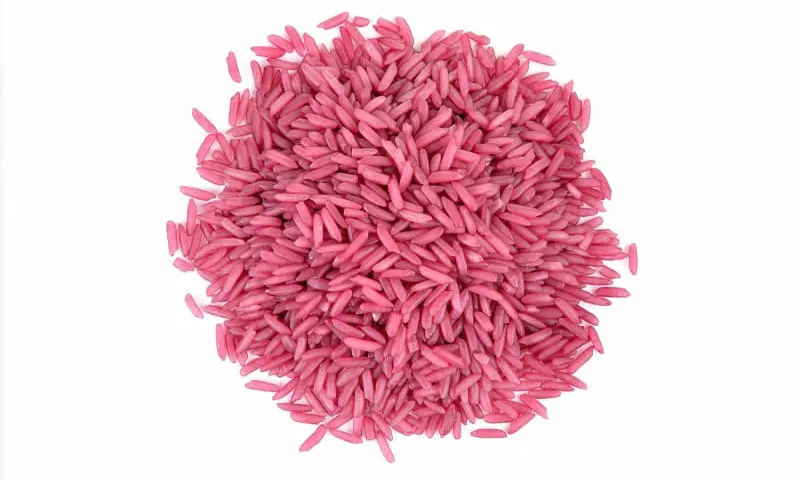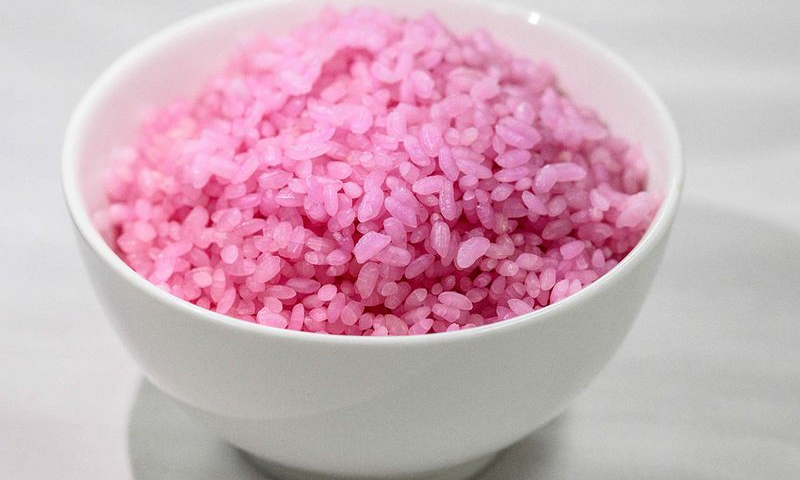SEOUL, South Korea: A team of South Korean scientists is pioneering a novel method to produce protein by injecting cultured beef cells into individual grains of rice. This innovation, led by Professor Hong Jin-kee of Seoul’s Yonsei University, holds the potential to transform global eating habits, from preventing famines to feeding astronauts in space.
Hong’s creation, dubbed “meaty rice,” resembles regular rice but with a pink hue and a faint buttery aroma, owing to the inclusion of beef muscle and fat cell cultures. This innovative food product aims to offer an eco-friendly and ethical protein source without harming animals. “We can obtain animal protein without the slaughter of livestock,” Hong told AFP.
This project addresses ethical and environmental concerns associated with industrial livestock rearing. Livestock farming is a significant contributor to greenhouse gas emissions, prompting a global search for sustainable meat alternatives. Hong’s background in organoids and biomedical sciences led him to choose rice as the medium for his research, given its status as a primary protein source in Asia.
The process involves coating a rice grain with fish gelatin, injecting it with beef cells, and culturing it in a petri dish for up to 11 days. The rice’s porous structure provides an ideal environment for uniform cell growth. The resulting “meaty rice” boasts eight percent more protein and seven percent more fat than regular rice.
Scaling up this process remains a challenge, but Hong is optimistic about its potential applications. He hopes to secure approval to use “meaty rice” as emergency relief food in two African countries, where even a slight increase in protein content can be vital for those with limited access to food.
South Korea has not yet approved any cultivated meat for consumption, but the government has committed millions to a “foodtech” fund and identified cell-cultured meat as a research priority. While cultivated meat is available in Singapore and the United States, it faces regulatory hurdles elsewhere, such as Italy, which banned it to protect its livestock industry.
Critics raise concerns about the safety of cultured meat, including the sourcing of animal cells and the use of serum, antibiotics, and hormones in the culturing process. Despite these concerns, Hong’s method significantly reduces the carbon footprint associated with protein production. His team estimates that producing 100 grams of protein releases 6.27 kilograms of carbon dioxide, eight times less than traditional beef production.
Cultured meat is often touted as a climate solution compared to conventional livestock. However, it must be scalable, affordable, energy-efficient, and environmentally friendly. Neil Stephens, a technology and society lecturer at the University of Birmingham, notes that “meaty rice” might have an advantage due to its hybrid nature, combining animal cells with plant material, potentially making it less energy-intensive and cheaper.
Global consultancy AT Kearney predicts that by 2040, only 40 percent of global meat consumption will come from conventional sources, with biotechnology playing a significant role in this shift. Hong envisions a future where biotechnology tailors food to individual health needs, potentially involving AI and robotic kitchens that prepare meals based on a person’s health metrics.
Hong’s “meaty rice” represents a step towards this future, promising a sustainable, ethical, and health-conscious alternative to traditional protein sources.


























![Pakistan is encountering dreadful terrorism and extremism. The government needs to revisit and reconstitute its counterterrorism strategy, which is grounded on popular support guaranteed through consensus in Parliament. Besides, an objective political dialogue among the political parties is the need of the hour for internal political stability and engaging the masses to quash effectively terrorist popular and physical sanctuaries. Indeed, without a consensus among the political parties over the launch of Operation Azm-e-Istehkam to combat the menace of terrorism in the country, it could be counterproductive. Since the United States-led NATO withdrawal from Afghanistan in August 2021, terrorist activities have increased rapidly in the country. The foreign-sponsored terrorist groups are targeting and killing law enforcement agencies' personnel, kidnapping and butchering innocent citizens and killing foreigners, especially Chinese, to spoil and thwart foreign direct investment in the country. Realizing the urgency, the government has initiated a new military operation to combat terrorism and extremism. On June 22, the Central Apex Committee of National Action Plan, chaired by Prime Minister Shehbaz Sharif, approved "Operation Azm-e-Istehkam" to eliminate terrorism and extremism nationwide. The presence of Federal Cabinet members, Chief ministers from all provinces and Gilgit-Baltistan, services chiefs, provincial chief secretaries, and other senior civilian, military, and law enforcement officials in the meeting reveal all the stakeholder's unanimity to reinvigorate and re-energize national counterterrorism campaign through the launch of Operation Azm-i-Istehkam. Operation Azm-e-Istehkam is a multipronged strategy with kinetic and non-kinetic stratagems, i.e., military, diplomatic, legislative, and socioeconomic plans to decisively defeat terrorism and extremism. "Azm-i-Istehkam will integrate and synergize multiple lines of effort to combat the menaces of extremism and terrorism comprehensively and decisively." The Pakistan Army has been bravely fighting with the terrorists since the 2009 Swat operation, but the diplomatic tier of the counterterrorism strategy was less effective. Operation Azm-e-Istehkam drives Islamabad to approach diplomatically likeminded states and coordinate with Shanghai Cooperation Organization’s Regional Anti-Terrorist Structure (RATS) to terminate the foreign financial and material support to terrorist groups such as Taliban (TTP), Balochistan Liberation Army (BLA), Daish (Islamic State Khorasan) involved in the terrorist attacks in the country. The Operation Azm-e-Istehkam is the need of the hour. Ironically, even before the launch of the operation, it received a divisive response from the parliamentarians due to the extreme polarization in the Pakistani polity. Pakistan Tehreek-e-Insaf members fiercely opposed the operation’s starting without the prior approval of the Parliament. The PTI Chairman Barrister Gohar said, "Any military operation must involve parliamentary consent. Parliament is supreme under the Constitution." In the parliamentary system of government, like the Pakistani political system, if the Cabinet approves any policy, including military operations, it is assumed that the majority in the Assembly endorses the decision. However, the opposition can call an in-camera session in the Parliament, even over sensitive issues. Defense Minister Khawaja Asif, instead of pacifying opposition lawmakers through dialogue or engagement, reacted viciously on the floor of the National Assembly. He said, “They (the opposition) are standing with the terrorists by protesting here today. They are protesting against the martyrs of the Pakistan Army and the army that is still making sacrifices to [counter] terrorism. They have not backed off from their May 9 stance even today.” Such a response to the PTI lawmakers in the National Assembly, particularly by the Defense Minister, increases disharmony and divisiveness in the Pakistani polity and negatively affects the operation. However, later, rationality prevailed, and Khawaja Asif said that the decision to conduct the operation would go "through the process," including a debate in Parliament’s in-camera session. He said, "It will go through the cabinet, then it will be presented in the House, and the House would be briefed.” One can expect a similar prudent response from the PTI leadership within and outside the Parliament. However, the statements of the PTI leaders are not encouraging. PTI leader Qaiser said, "Our belief is that a military operation is not the solution. All political parties must play their role to establish peace in the province." He is ignoring the fact that the battle-hardened foreign sponsored terrorist groups necessitate kinetic action. In the present pessimistic political situation, Pakistan Peoples Party chairman Bilawal Bhutto-Zardari’s visionary recommendation has germinated optimism. On June 21, he drew attention to the cardinal cause of the internal insecurity: “The politics of hatred in Islamabad is at its peak.” He rightly called for a dialogue among all democratic forces to take the country out of the crisis. He said, "There're many leaders who're not even ready to talk. They don't want to even shake hands with each other. I urge them all once again that all political parties, whether they're in the government or opposition, initiate dialogue with all political forces. Don't let your ego or personal issues dominate this process. If you want to bring Pakistan out of economic crisis and strengthen the Parliament, you would have to talk to democratic forces." Indeed, the country's stability is out of the question without swapping enmity with amity among the political forces. Thus, the political leaders, especially PML-N and PTI, should listen to Mr. Bilawal and initiate a respectful and civilized discussion to steer the country out of the numerous crises, including extremism and militancy. To conclude, a consensual national strategy to combat the menace of terrorism is impossible without recuperating the tumultuous landscape of Pakistani politics. Indeed, the government is responsible for engaging the opposition on the national security issue. Conversely, the opposition party realizes its duty to provide an alternative vision and policy instead of adopting a rejectionist approach.](https://wenewsenglish.pk/wp-content/uploads/2024/06/apex-2-300x180.jpg)
